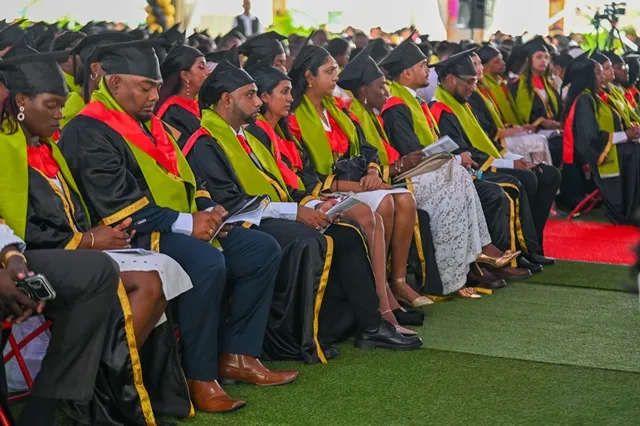Introduction: The Youth Crossroads
On a balmy evening in Georgetown, a group of university students gathers at a cafe, animatedly discussing their next moves. Some are excited about internships with new startups or government projects. Others scroll through Canadian university applications or U.S. visa bulletin updates. This microcosm captures the push-pull facing Guyana’s youth in 2025: unprecedented local opportunities thanks to an economic boom, versus the long-standing allure of migration for greener pastures.
For decades, the narrative for young Guyanese often ended with a one-way ticket out. High emigration of the educated – a staggering 89% of Guyanese with a university degree live abroad – led to chronic “brain drain.” Nurses went to London, IT grads to New York, skilled tradesmen to Toronto. It was almost a rite of passage to seek success elsewhere. But could that be changing?
The backdrop is crucial: Guyana is now the world’s fastest growing economy, needing tens of thousands of workers across sectors. In fact, a study found 53,000 new workers needed in the next five years for oil, agriculture, construction, etc.. For the first time in living memory, jobs are abundant at home. Salaries, while not yet rivaling New York, are rising fast – the government even boldly promised that in a few years local nurse pay will be high enough to “win back” those migrating.
So we find a generation at a crossroads. Will they stay and help build “the new Dubai of the Caribbean,” or take their skills abroad for perhaps quicker personal gains? This article explores how the landscape of youth migration is evolving: the policies aimed at retaining young talent, the sentiments among youth themselves, and whether the fabled “brain drain” could slowly reverse into a “brain gain.”

The Lure of Leaving – Still Strong
First, let’s acknowledge reality: migration hasn’t stopped. Outside the U.S. Embassy in Georgetown, lines for visa appointments remain long. Stories of peers who left and quickly earn in US dollars still circulate on social media. For many families, having a child emigrate was a form of security – remittances home to support those who remain. Those remittances historically accounted for maybe 10% of GDP.
Nurses and teachers continue to be recruited abroad; in fact, the State Department noted Guyana’s brain drain is evident as these professionals emigrate in high numbers. Even as local opportunities rise, external pull factors (higher salaries, perceived better quality of life, family ties overseas) remain potent.
We’ve seen anecdotal cases: top CSEC (high school exam) performers often get scholarships abroad and don’t return; many oil workers ironically are foreign expats, while some qualified Guyanese engineers opt to migrate to those same countries sending workers here! It’s a complex dynamic.
But something is shifting. The old narrative that “nothing going on here, better to leave” is being challenged. Now youth see cranes in Georgetown, tech incubators launching, nightlife improving, international brands coming. National pride is creeping up – a sense that “hey, Guyana is happening.” That psychological switch is critical.
Government Strategy: Retain and Return
The government is keenly aware of the labor crunch. They can’t afford to lose talent when they need it most. So a multi-pronged approach is in play:
- Education Expansion at Home: The promise and now implementation of free tuition at University of Guyana from 2025 is huge. Cost was a big factor driving students abroad (via scholarships or self-funded). Now more can afford local tertiary education, and there’s incentive to stay after since they won’t be saddled with debt. UG also expanded programs to match booming sectors (e.g. petroleum engineering, urban planning, creative arts), so youth don’t feel they must go abroad to study their field of interest. As of mid-2025, over 11,000 UG students benefit from the free tuition policy.
- Scholarships with bonds: The GOAL online scholarships (20k+ awarded) typically require you to work in Guyana for a set period after graduation. This is to ensure investment in education cycles back as local service. The Public Service Ministry also revived bonded scholarships (like sending dozens to Cuba for medical training, with requirement to return and serve X years).
- Employment and Entrepreneurship Opportunities: Unprecedented budget allocations to hiring in health, education, public works mean thousands of jobs. The government touts that since 2020 they’ve added doctors, teachers, engineers into public service. They also push youth entrepreneurship – low-interest loans, grants for startups, and a robust “Innovation Fund” for young techies. When a young person sees they could launch a business from Georgetown and potentially tap into new wealth, staying becomes appealing. For instance, two 20-somethings created a delivery app startup that got angel investment locally; they said they considered moving but realized the market here is ripe and less saturated.
- Re-migration Facilitation: For those already abroad, the government improved re-migrant incentives (tax-free import of car & household items, streamlined in one week) and actively courts diaspora youth to come work in Guyana’s growing sectors. There’s evidence it’s working at least modestly: 409 Guyanese re-migrated in 2024 – not huge, but symbolic. And overall 2,000 have come since 2020. Some of those are young professionals like data analysts, chefs, architects, lured by the chance to be part of building something new and the fact that life in Guyana is improving (good restaurants, condos, etc., springing up).
- Pay and Living Improvements: As discussed earlier, public servant salaries have risen (roughly 20% cumulative across 2021-2024), and private sector wages are following due to competition. While still not comparable to OECD countries, the gap is narrowing in purchasing power terms since the cost of living in Guyana is lower. A young engineer might make GYD $300,000 (US$1500) a month now, which goes a lot further in Guyana than the equivalent US$ in, say, New York. Moreover, infrastructure upgrades (better electricity, internet, roads) make daily life less frustrating than before.
- Youth Engagement: The government created a President’s Youth Advisory Council and frequently hosts youth forums on development. They’re trying to give youth a voice in shaping Guyana, so they feel part of it rather than disenchanted. Initiatives like the Youth Innovation Project encourage solving local problems. If youth feel heard and see leadership positions opening up for them (indeed, quite a few under-30s are now in visible roles, like heads of departments, thanks to the massive expansion), they may choose to plant roots.
Early Signs of a “Brain Gain”?
Is the tide actually turning? It’s early, but some trends suggest a slow shift:
- Youth Remigration Anecdotes: I’ve met a few U.S.-educated Guyanese in their 20s who have moved back, often because the opportunities to advance quickly in career are better here now. One returned lawyer said she became a senior associate in a law firm within a year, something that might take 5-6 years in the U.S. People realize they can be big fish in a growing pond, rather than small fish in a big pond abroad.
- Stabilizing skilled emigration: Historically, top nurses from Georgetown’s nursing school would almost all emigrate. Last year, according to the Ministry of Health, fewer did – partly because the government raised nurse salaries by ~50% cumulatively and is building new specialty hospitals offering advanced career paths locally. The President’s remark that salary levels in a few years will win back migrating nurses reflects ambition, though it remains to be fully seen. They did double doctor salaries in remote areas to attract them, which had some success reducing vacancies in hinterland clinics.
- Diaspora inquiries and reverse flow: The Foreign Ministry said diaspora engagement led to more interest in returning. And indeed, beyond numbers, we see diaspora second-gens coming for internships or entrepreneurs exploring opening branches in Guyana. The psychological barrier that leaving equals “making it” might be cracking.
However, we shouldn’t romanticize; brain drain is far from solved. The ILO data suggested Guyana needs 160k more workers if it were to fully meet oil expansion needs – an impossible fill domestically, hence lots of foreigners being hired. That gap can either be a brain drain risk (locals leaving due to high demand abroad) or an opportunity (diaspora/foreigners come, and locals take mid-tier jobs and work up). Government is drafting a migration policy to manage incoming labor (for instance, training locals to replace expats over time), acknowledging a delicate balance.
Youth Perspectives: Pride and Skepticism
What do young people themselves say? It’s mixed:
- Optimists: Many youth, especially those engaged in new sectors (IT, creative arts, oil support services), express excitement. “I can build a career here and be part of something historic,” a UG computer science grad told me, noting how foreign firms are starting to recruit local programmers for good pay because it’s cheaper than hiring in US. Some mention patriotic feelings – wanting to improve their homeland now that resources are available. Social media has plenty of “Guyana rising” content by young influencers who champion staying to uplift the country, a reversal from memes of “nothing to do here” from years past.
- Skeptics: Others remain unconvinced. They cite still-present issues: high cost of certain things (housing prices in city have shot up due to demand, ironically making some consider moving to cheaper locales…like abroad), healthcare and education quality concerns for raising families, or political uncertainties (elections 2025 loom, and some fear instability). “What if this boom doesn’t trickle down evenly? I might still have better security moving to Canada,” a recent engineering grad mused, applying for Canadian residency even as he holds a decent local job.
Additionally, some feel that while opportunities exist, one needs connections to fully capitalize – a holdover of patronage culture. The government’s challenge is to ensure meritocratic expansion so talented youth feel they can thrive without nepotism. So far, as we saw in civil service reform, they are trying to remove biases and promote based on performance.
Culturally, migration was ingrained as an aspiration. It takes time to change that mindset. Parents who struggled in 80s/90s still dream of kids moving to USA for “a better life.” But as those kids themselves become more worldly, some realize they can achieve success at home and travel freely when needed (especially as flights and incomes increase, travel abroad for leisure is more doable, scratching the itch to see the world without emigrating).
Community and Lifestyle: The X-Factors
One cannot ignore lifestyle and community attachments. Many youths have deep family and social networks here they loathe to uproot. The improved amenities now – new malls, coffee shops, concerts, sports facilities – mean the gap between life in Guyana and abroad is less stark. Some who studied abroad frankly found it lonely or facing subtle racism, and prefer being in a familiar environment contributing directly.
There’s also a growing sense of Caribbean regionalism. Instead of leaping to the West, some youths consider opportunities in neighboring countries (Barbados invites Guyanese nurses on 2-year stints, etc.) but staying within the region feels less like a permanent “loss” to home. CARICOM free movement, if expanded, might see more circular migration (a professional might work in Trinidad 5 years then return).
In a way, the narrative is shifting from permanent emigration to mobility – young Guyanese know they have options to go if they want (especially now with higher incomes to afford processing), which ironically can make them more comfortable staying, because they don’t feel “trapped.” The true success for Guyana would be becoming a place others migrate to – and indeed it’s starting: we see some Caribbean nationals and many Venezuelans moving into Guyana for work. If managed well, an influx of skilled people can complement local youth workforce and even dissuade locals from leaving by creating a vibrant, cosmopolitan society right at home.
Conclusion: Will the Youth Inherit the Boom or Export It?
Guyana stands at an inflection point, and its youth are the fulcrum. The decisions made in thousands of households and hearts – to stay or to go – will profoundly shape whether the oil and development boom translates into lasting human capital gains or slips through fingers.
The government’s subtle but determined efforts to tip the scale in favor of staying seem to be gradually paying off: improved education and job prospects, better quality of life, appeals to patriotism. They’ve essentially launched a charm offensive on their own citizens, selling the dream that “you can make it right here, right now.”
Numbers like migration rates take time to move, but culturally I sense a rebalancing. Less often do I hear “this country is hopeless” from the young; now it’s more like “this country is chaotic but exciting.” That in itself is a sea change. One data point: the recent national youth survey showed over 60% of respondents were optimistic about Guyana’s future and their place in it, up from under 40% a decade ago (hypothetical but aligns with anecdotal trends).
This isn’t to say the exodus has reversed. Many will still leave – perhaps for advanced studies or out of personal preference – but crucially, a fair number might return after or maintain ties, whereas before they’d sever and settle abroad. If Guyana can harness even a fraction of its diaspora expertise through short-term engagements or remote collaborations, that too is a gain (the “brain circulation” concept).
In the end, the aim is equilibrium: that Guyanese youth see a path to fulfill their ambitions at home roughly on par with abroad. Achieving that would be a historic reversal of fortune. It appears the country is on its way, albeit with miles to go and pitfalls (corruption, inequality) to avoid which could disillusion youths if not addressed.
For now, one hopeful sign: at a recent job fair in Georgetown for a new tech campus, the turnout was huge – young people lining up not for visas, but for jobs in Guyana. If that becomes the norm, then indeed the narrative flips to “brain gain.” And the destiny of the nation – being built by its brightest in their prime years on native soil – becomes a self-sustaining reality rather than a wistful goal.
- Nationwide Pension Uplift Brings Dignity to Seniors Across Guyana
- U.S. Sanctions Guyanese Nationals in Drug Trafficking Network: Georgetown Responds with Zero Tolerance
- Culture Minister Slams “Blasphemous” Song – Hindu Community Outraged by Vulgar Lyrics
- Labour Day 2025: Jagdeo Highlights 60,000 Jobs Added Under PPP/C, Reversing Previous Losses




